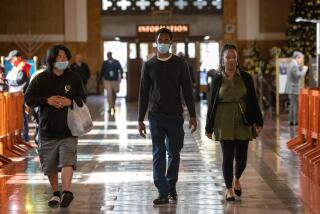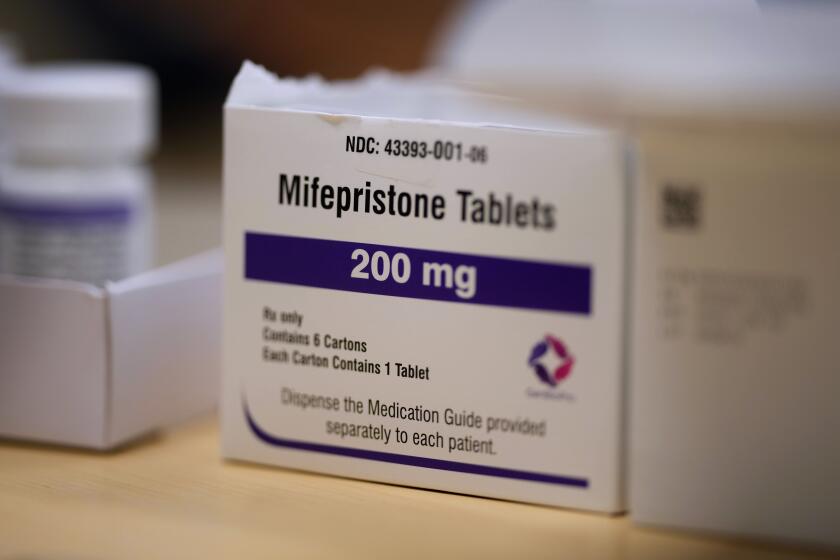Scientists Offer Explanation of HIV Resistance
- Share via
Perhaps one in every 100 whites is genetically resistant to infection by the AIDS virus, two sets of researchers have found.
The finding not only explains why some repeatedly exposed individuals do not develop the disease, researchers said, but also offers the possibility of developing an effective way to block the spread of the fearsome virus.
Earlier this summer, researchers identified a so-called co-factor, called CCR5, that is crucial to infection of human cells by the human immunodeficiency virus.
Now, in studies of more than 1,400 people, teams from New York and Pennsylvania have independently found that cells from individuals who receive a copy of the defective CCR5 gene from each of their parents are completely resistant to HIV infection.
The studies also showed that those who received a defective copy from only one parent, representing about 20% of the white population, appear to be more resistant to infection than others, but not completely immune, the teams report today in the journal Cell and next week in Nature.
Because the defective gene apparently causes no adverse effects, researchers believe that if a drug can be developed to block the CCR5 receptor, it could markedly slow the AIDS epidemic.
“This paper has very important scientific implications and potentially important therapeutic implications,” said Dr. Anthony Fauci, head of the National Institute of Allergy and Infectious Diseases. “They have very clearly and conclusively proved that this is an explanation for why some people are exposed and unaffected. But it is not the only reason.”
Nonetheless, CCR5 defects play a bigger role in AIDS resistance than many researchers had predicted. “We originally thought people like this would be one in a million,” said Dr. Nathan R. Landau of the Aaron Diamond AIDS Research Center in New York City, who led one of the teams. The studies showed that “it is more like one in 100” among Western European whites.
The defect is much rarer, however, in people from Central Africa and Japan--so rare that neither team has yet observed it after studying several hundred people from those areas.
Researchers have known virtually since the beginning of the AIDS epidemic that HIV binds to a receptor called CD4 on the surface of human cells. But it has been equally clear that the virus requires the participation of a second protein--a co-factor--before it can actually enter and infect the cells. The identity of that co-receptor was a fervently investigated mystery until this summer, when three teams of researchers found that it is a protein called CCR5.
Many researchers then began looking for subtle changes in CCR5 that might alter the likelihood of cells being infected.
Landau and his colleagues initially studied two gay men who had been repeatedly exposed to the virus but had not been infected. The team found that both men had inherited two mutant copies of the CCR5 gene. In test-tube studies, the men’s white blood cells--the normal target of HIV--were completely resistant to infection by the most commonly transmitted strain of HIV.
Cells from individuals with only one defective copy of the gene could be infected in the laboratory, but they produced only one-quarter to one-tenth as many viruses as did normal CCR5 cells. Landau and others speculated that this may explain why some HIV-positive individuals take much longer to progress to full-blown AIDS.
They cautioned, however, that much more work will be required to verify that suspicion.
In the paper to be published next week, Dr. Robert W. Doms of the University of Pennsylvania Medical Center and colleagues in France and Belgium also identified individuals with two defective copies of the gene and found that their white cells were resistant to infection.
They then studied more than 700 HIV-positive Europeans and an equal number of uninfected Europeans, looking for genetic variations in CCR5. Among the uninfected group, they found that about one in every 100 people had two defective copies and about one in every five had one defective copy.
Among the HIV-positive people, however, the team found none with two defective copies, suggesting that having two defective copies makes people “highly resistant to HIV infection,” Doms said. The number in the HIV-positive group with only one defective copy was 35% lower than in the uninfected group. “It’s too early to tell if having one copy of the mutant gene might make people partly resistant to virus infection,” Doms said. “But it is a possibility that we and others are investigating.”
Both Doms and Landau observed that individuals with two defective copies of the gene apparently suffer no ill effects as a result of their genetic inheritance. “This is important, because it means that CCR5 is not essential,” Doms said. “If we can design drugs that block CCR5, then those drugs may block virus infection without significant side effects.”
“This gives us a new target [for blocking HIV infections] and some confidence that this target is biologically important,” said Dr. William Paul, head of the Office of AIDS Research at the National Institutes of Health. “I think it is a big step.”
Fauci noted that many researchers in both industry and academia are avidly searching for drugs that will block CCR5, but conceded that the search “is still in its infancy.”
Fauci and others cautioned that the virus may find alternative ways into cells and warned people with two defective copies not to abandon safe sex practices. “That would be folly,” he said. “We are just on the threshold of understanding all of this.”





